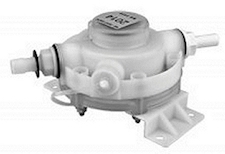A cask breather (or respirator), above, can be a good addition to your setup (if this bothers you as a pure cask geek, skip down to my last paragraph) . The device hooks to a CO2 regulator and supplies CO2 to the head space when it senses a vacuum in the cask. I have only owned one in my life and I quickly realized that if you hook one up to a cask that has not had all of its’ CO2 vented off or in reality its’ positive pressure bled off, the respirator with bleed it off for you. I guess this is what it’s supposed to do.
From what I’ve gathered about CO2 and beer, if CO2 is in solution (in beer) and in a sealed container, the CO2 stays in the liquid. Essentially, the CO2 in the liquid stays equal to the CO2 in the headspace. If the container is opened, the headspace leaks out and the equilibrium goes away and the CO2 starts to come out of the liquid. Over time, your beer goes flat.
If you think about this, if you are presenting a cask over a period of time, it is going to let the CO2 equilibrium go out of balance and your cask goes flat quicker. I purchased a bag of check valves off eBay.
I put one of these in the tube between the respirator and cask. CO2 can come in through the tube, but can’t flow back to the respirator. I have proven that this really keeps the carbonation in my casks longer. I have found that my casks keep their carbonation 2-3 days which is what I need to get most of the cask sold.
It is a common belief is that CAMRA speaks out against respirators. In the CAMRA backed book on cellaring, there is a good bit on using them. If you are playing with casks in the United States (or anywhere really) and are doing it per tradition, then using one is the best thing you can do to spread the word about Real Ale. If your beer is presentable longer, you are doing the idea of Real Ale a service. Bravo to you.
I stole the cask breather photo from UK brewing supplies.

